Scientific Papers in SCI
2021
2021
Materiales de Diseño para la Energía y Medioambiente
Pb2+, Cd2+ and Hg2+ removal by designed functionalized swelling high-charged micas
Osuna, FJ; Pavon, E; Alba, MDScience of The Total Environment, 764 (2021) 142811
Show abstract ▽
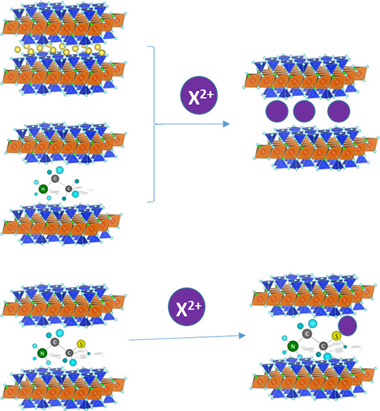
The increasing accumulation of toxic heavy metals in the environment has generated the need of efficient removal systems, being the adsorption method the most popular one applied in aqueous solutions. Of particular concern is the case of Pb2+, Cd2+ and Hg2+ due to their high potential hazard. In this paper, we describe the feasibility of a new family of nanomaterials, swelling high charge micas, in the removal of these cations from aqueous solutions. Batch adsorption experiments were carried out in the as-made micas, NaMn, and after functionalization with ethylammonium, EA-Mn, and mercaptoethylammonium, MEA-Mn. The results have demonstrated that all of them are efficient heavy metal adsorbents, being Na-M2 the best adsorbent for Pb2+ and Cd2+, and, MEA-M2 for Hg2+.
April, 2021 | DOI: 10.1016/j.scitotenv.2020.142811
Materiales y Procesos Catalíticos de Interés Ambiental y Energético
LED-driven controlled deposition of Ni onto TiO2 for visible-light expanded conversion of carbon dioxide into C-1-C-2 alkanes
Sanz-Marco, A; Hueso, JL; Sebastian, V; Nielsen, D; Mossin, S; Holgado, JP; Bueno-Alejo, CJ; Balas, F; Santamaria, JNanoscale Advances
Show abstract ▽
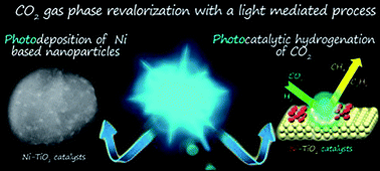
Photocatalytic gas-phase hydrogenation of CO2 into alkanes was achieved over TiO2-supported Ni nanoparticles under LED irradiation at 365 nm, 460 nm and white light. The photocatalysts were prepared using photo-assisted deposition of Ni salts under LED irradiation at 365 nm onto TiO2 P25 nanoparticles in methanol as a hole scavenger. This procedure yielded 2 nm Ni particles decorating the surface of TiO2 with a nickel mass content of about 2%. Before the photocatalytic runs, Ni/TiO2 was submitted to thermal reduction at 400 °C in a 10% H2 atmosphere which induced O-defective TiO2−x substrates. The formation of oxygen vacancies, Ti3+ centers and metallic Ni sites upon photocatalytic CO2 hydrogenation was confirmed by operando EPR analysis. In situ XPS under reaction conditions suggested a strong metal–support interaction and the co-existence of zero and divalent Ni states. These photoactive species enhanced the photo-assisted reduction of CO2 below 300 °C to yield CO, CH4 and C2H6 as final products.
April, 2021 | DOI: 10.1039/d1na00021g
Nanotecnología en Superficies y Plasma
Electrochromic response and porous structure of WO3 cathode layers
Louloudakis, D; Mouratis, K; Gil-Rostra, J; Koudoumas, E; Alvarez, R; Palmero, A; Gonzalez-Elipe, ARElectrochimica Acta, 376 (2021) 138049
Show abstract ▽
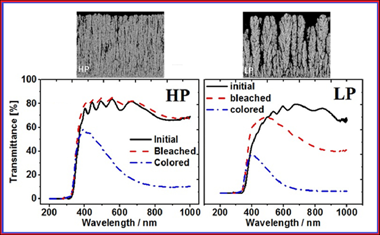
Maximizing the electrochromic response of tungsten oxide-based systems demands highly porous electrode layers that facilitate the incorporation of electrolyte cations during the reduction process. In this work, amorphous and porous WO3 thin films were grown on indium tin dioxide glass substrates by magnetron sputtering at oblique angles at two different plasma gas pressures. Remarkably, the film that showed higher porosity presented a worse electrochromic response in terms of durability, time response and charge density capacity. This result is analyzed and explained on the basis of the features of the porous structure of the films: While the typical nanostructure developed at low pressures possesses large and connected pore voids with few ramifications, the nanostructure generated at a higher pressure presents a rather sponge-like porous structure with numerous and small well-connected voids. A general discussion on the role of the porous structure and, particularly, on the accessible pore volume and area is carried out. It is concluded that not only the accessible pore volume, defining the volume of electrolyte that stays inside the layer, but also the accessible pore area, which defines the efficiency of the incorporation/release of Li+ cations within the electrode material, determine the efficiency and reversibility of the electrochromic response.
April, 2021 | DOI: 10.1016/j.electacta.2021.138049
Química de Superficies y Catálisis
Cu supported Fe-SiO2 nanocomposites for reverse water gas shift reaction
Gonzalez-Castano, M; de Miguel, JCN; Sinha, F; Wabo, SG; Klepel, O; Arellano-Garcia, HJournal of CO2 Utilization, 46 (2021) 101493
Show abstract ▽
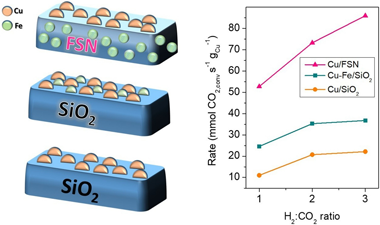
This work analyses the catalytic activity displayed by Cu/SiO2, Cu-Fe/SiO2 and Cu/FSN (Fe-SiO2 nanocomposite) catalysts for the Reverse Water Gas Shift reaction. Compared to Cu/SiO2 catalyst, the presence of Fe resulted on higher CO?s selectivity and boosted resistances against the constitution of the deactivation carbonaceous species. Regarding the catalytic performance however, the extent of improvement attained through incorporation Fe species strongly relied on the catalysts' configuration. At 30 L/gh and H-2:CO2 ratios = 3, the performance of the catalysts? series increased according to the sequence: Cu/SiO2 < Cu-Fe/SiO2 << Cu/FSN. The remarkable catalytic enhancements provided by Fe-SiO2 nanocomposites under different RWGS reaction atmospheres were associated to enhanced catalyst surface basicity's and stronger Cu-support interactions. The catalytic promotion achieved by Fe-SiO2 nanocomposites argue an optimistic prospective for nanocomposite catalysts within future CO2-valorising technologies.
April, 2021 | DOI: 10.1016/j.jcou.2021.101493
Materiales para Bioingeniería y Regeneración Tisular
Nanofibrous Matrix of Defined Composition Sustains Human Induced Pluripotent Stem Cell Culture
Borrego-Gonzalez, S; de la Cerda, B; Diaz-Corrales, FJ; Diaz-Cuenca, AACS Applied Bio Materials, 4 (2021) 3035-3040
Show abstract ▽
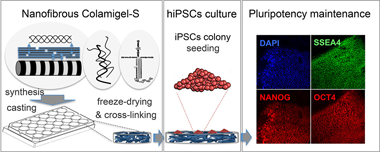
Human induced pluripotent stem cells (hiPSCs) represent the most promising biological material for regenerative medicine applications. In this work, a 3D solid nanofibrous matrix of defined composition (Colamigel-S) consisting of 97 wt % gelatin, 2.6 wt % atelocollagen, and 0.4 wt % laminin has been reproducibly processed and characterized and exhibits a homogeneous nanofibrillar network of high surface area, interconnected microcavities, and typical D-periodic collagen fibril nanostructural features. The purpose of the study was to test the performance of Colamigel-S as substrate for in vitro hiPSCs culture, finding that these cells efficiently attach and grow keeping their characteristic stem morphology and undifferentiated state.
April, 2021 | DOI: 10.1021/acsabm.0c00425
- ‹ previous
- 79 of 410
- next ›














